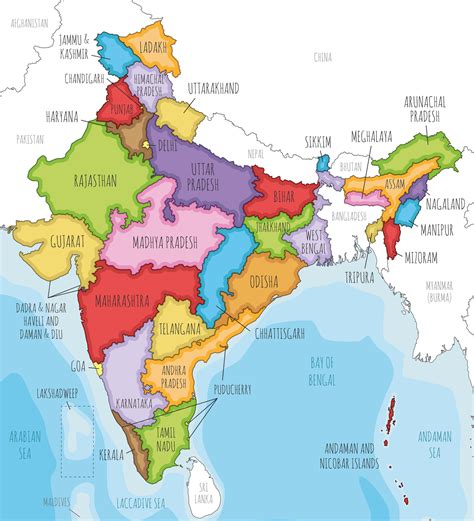Size Of India Compared To The United States

The comparison of the size of India to the United States is a fascinating topic that highlights the significant geographical differences between these two nations. India, located in South Asia, is the seventh-largest country in the world by land area, covering approximately 3,287,263 square kilometers (1,269,219 square miles). On the other hand, the United States, situated in North America, is the third-largest country globally, spanning around 9,833,517 square kilometers (3,805,927 square miles). This disparity in size is evident when considering that the United States is roughly 3 times larger than India.
One way to visualize this size difference is by comparing the geographical features of both countries. India's diverse landscape includes the Himalayan mountain range in the north, the Indo-Gangetic Plain, and the Deccan Plateau in the south. In contrast, the United States boasts an equally varied geography, with the Rocky Mountains in the west, the Great Plains in the center, and the Appalachian Mountains in the east. Despite these similarities in geographical diversity, the sheer scale of the United States dwarfs that of India, with the former's vast expanses of land encompassing numerous climates, ecosystems, and natural wonders.
Key Points
- India is approximately 3,287,263 square kilometers (1,269,219 square miles) in size, making it the seventh-largest country globally.
- The United States covers around 9,833,517 square kilometers (3,805,927 square miles), ranking it as the third-largest country in the world.
- The size difference between the two nations is significant, with the United States being roughly 3 times larger than India.
- Both countries exhibit diverse geographical features, including mountain ranges, plains, and plateaus.
- The size disparity between India and the United States has implications for their respective economies, populations, and environmental challenges.
Geographical Comparison and Implications

The size difference between India and the United States has profound implications for various aspects of their societies and economies. For instance, the larger size of the United States contributes to its more extensive natural resources, including fossil fuels, timber, and minerals. In contrast, India’s smaller size means it has relatively limited natural resources, making it more reliant on imports to meet its energy and raw material needs. Furthermore, the geographical diversity of both countries supports a wide range of ecosystems, biodiversity, and climates, which in turn pose distinct environmental challenges and conservation opportunities.
Population Density and Urbanization
Another critical aspect to consider when comparing the size of India to the United States is population density and urbanization patterns. Despite being significantly smaller, India has a population of over 1.38 billion people, which is roughly 4 times the population of the United States (approximately 331 million people). This disparity results in vastly different population densities, with India averaging about 460 people per square kilometer, compared to the United States’ average of 36 people per square kilometer. The implications of these density differences are evident in the urbanization trends of both countries, with India facing unique challenges related to rapid urban growth, infrastructure development, and resource management.
| Country | Land Area (km²) | Population (2020 est.) | Population Density (people/km²) |
|---|---|---|---|
| India | 3,287,263 | 1,380,090,000 | 460 |
| United States | 9,833,517 | 331,449,281 | 36 |

Economic and Environmental Perspectives

From an economic standpoint, the size difference between India and the United States influences their respective economic structures, trade patterns, and development trajectories. The United States, with its larger size and more extensive natural resources, has historically been a major player in global trade, leveraging its economic and military power to shape international relations and commerce. India, on the other hand, has been rapidly growing its economy, driven by its large and skilled workforce, strategic investments in technology and infrastructure, and a growing consumer market. However, India’s smaller size and limited natural resources mean it must adopt more efficient and innovative approaches to achieve sustainable economic growth and environmental stewardship.
Environmental challenges are another critical area where the size difference between India and the United States has significant implications. Both countries face pressing issues related to climate change, air and water pollution, and biodiversity conservation. However, the larger size of the United States means it has a greater carbon footprint and contributes more to global greenhouse gas emissions. In contrast, India's smaller size and rapidly growing economy pose unique challenges related to balancing economic development with environmental protection and sustainable resource management.
Strategic Considerations and Future Directions
In conclusion, the comparison of India’s and the United States’ sizes offers valuable insights into their respective strengths, challenges, and opportunities. As both nations continue to grow and evolve, it is essential to consider the strategic implications of their size difference. For India, this means leveraging its human capital, technological advancements, and innovative spirit to drive sustainable economic growth and environmental stewardship. For the United States, it involves recognizing the global impact of its size and economic influence, while adopting more sustainable and inclusive development pathways that address the needs of its diverse population and the planet as a whole.
What is the approximate size difference between India and the United States?
+The United States is roughly 3 times larger than India, with the former covering approximately 9,833,517 square kilometers and the latter spanning around 3,287,263 square kilometers.
How does the population density of India compare to that of the United States?
+India has a significantly higher population density than the United States, with an average of 460 people per square kilometer compared to the United States’ average of 36 people per square kilometer.
What are the implications of the size difference between India and the United States for their economies and environments?
+The size difference has significant implications for their economies, with the United States having more extensive natural resources and India facing challenges related to rapid urbanization and resource management. Environmentally, the larger size of the United States contributes to a greater carbon footprint, while India’s smaller size poses unique challenges related to balancing economic development with environmental protection.



